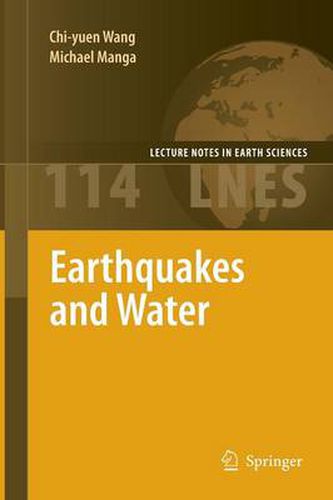Readings Newsletter
Become a Readings Member to make your shopping experience even easier.
Sign in or sign up for free!
You’re not far away from qualifying for FREE standard shipping within Australia
You’ve qualified for FREE standard shipping within Australia
The cart is loading…






This title is printed to order. This book may have been self-published. If so, we cannot guarantee the quality of the content. In the main most books will have gone through the editing process however some may not. We therefore suggest that you be aware of this before ordering this book. If in doubt check either the author or publisher’s details as we are unable to accept any returns unless they are faulty. Please contact us if you have any questions.
Distantearthquakesarewellknowntoinduceawiderangeofresponsesinsurface water and groundwater. These responses are often viewed as mere curiositiesas theiroccurrenceislimitedinspaceandtime.Thefrequentemphasisonearthquake precursorsinstudiesofthesephenomenaalsotendstopushthestudyof'earthquake hydrology’ away from the mainstream of geoscience. The observed phenomena, however,probetheinteractionbetweenhydrogeologicalprocessesandmechanical deformationintheshallowcrust.Hencetheyprovideinsightintotheinteraction among water cycle, tectonics, and properties of the crust. As such, the study of earthquakehydrologyalsohasthepotentialtoprovideamorequantitativeand- depthunderstandingofthenatureofearthquakeprecursorsandevaluatewhether theyareinfactprecursors. The title of this book re ects the nature of the connections we address: we focus on how earthquakes affect hydrology. Water also in uences earthquakes as it affects the strength of faults and the rheology of rocks. Our emphasis here, however, is not on the hydrology of earthquakes, but on understanding the hydrological phenomena induced or modi ed by earthquakes. The boundary betweenthe'hydrologyofearthquakes'andthe'earthquake-inducedhydrological phenomena’, however, can sometimes be blurred. For example, triggered ear- quakes are sometimes explained by a re-distribution of pore pressure following the triggering earthquake. Hence, triggered seismicity may be an example of an earthquake-induced hydrological phenomenon. Thestudyofthelatter,therefore, canbeimportanttowardsabetterunderstandingofthemechanicsofatleastsome earthquakes. Therearemanystudents,postdocsandcolleagueswewishtothankforcolla- ratingonresearchprojectsrelatedtothetopicsreviewedinthisbook,orparticip- inginstimulatingdiscussionsintheclasswetaughtcalled'Earthquakehydrology’. In particular, we wish to thank Emily Brodsky, Yeeping Chia, Douglas Dreger, Shemin Ge, Fu-qiong Huang, Tom Holzer, Chris Huber, Joel Rowland, Martin Saar, Yaolin Shi, Chung-Ho Wang, Kelin Wang, Pei-ling Wang and Alex Wong forenlighteningexchanges.HunterPhilsonhelpedwith guresandtheindex.We v vi Preface alsothanktheNationalScienceFoundation,theMillerInstituteforBasicResearch inScience,andNASAforsupportingtheresearchandsynthesisinthisvolume.
$9.00 standard shipping within Australia
FREE standard shipping within Australia for orders over $100.00
Express & International shipping calculated at checkout
This title is printed to order. This book may have been self-published. If so, we cannot guarantee the quality of the content. In the main most books will have gone through the editing process however some may not. We therefore suggest that you be aware of this before ordering this book. If in doubt check either the author or publisher’s details as we are unable to accept any returns unless they are faulty. Please contact us if you have any questions.
Distantearthquakesarewellknowntoinduceawiderangeofresponsesinsurface water and groundwater. These responses are often viewed as mere curiositiesas theiroccurrenceislimitedinspaceandtime.Thefrequentemphasisonearthquake precursorsinstudiesofthesephenomenaalsotendstopushthestudyof'earthquake hydrology’ away from the mainstream of geoscience. The observed phenomena, however,probetheinteractionbetweenhydrogeologicalprocessesandmechanical deformationintheshallowcrust.Hencetheyprovideinsightintotheinteraction among water cycle, tectonics, and properties of the crust. As such, the study of earthquakehydrologyalsohasthepotentialtoprovideamorequantitativeand- depthunderstandingofthenatureofearthquakeprecursorsandevaluatewhether theyareinfactprecursors. The title of this book re ects the nature of the connections we address: we focus on how earthquakes affect hydrology. Water also in uences earthquakes as it affects the strength of faults and the rheology of rocks. Our emphasis here, however, is not on the hydrology of earthquakes, but on understanding the hydrological phenomena induced or modi ed by earthquakes. The boundary betweenthe'hydrologyofearthquakes'andthe'earthquake-inducedhydrological phenomena’, however, can sometimes be blurred. For example, triggered ear- quakes are sometimes explained by a re-distribution of pore pressure following the triggering earthquake. Hence, triggered seismicity may be an example of an earthquake-induced hydrological phenomenon. Thestudyofthelatter,therefore, canbeimportanttowardsabetterunderstandingofthemechanicsofatleastsome earthquakes. Therearemanystudents,postdocsandcolleagueswewishtothankforcolla- ratingonresearchprojectsrelatedtothetopicsreviewedinthisbook,orparticip- inginstimulatingdiscussionsintheclasswetaughtcalled'Earthquakehydrology’. In particular, we wish to thank Emily Brodsky, Yeeping Chia, Douglas Dreger, Shemin Ge, Fu-qiong Huang, Tom Holzer, Chris Huber, Joel Rowland, Martin Saar, Yaolin Shi, Chung-Ho Wang, Kelin Wang, Pei-ling Wang and Alex Wong forenlighteningexchanges.HunterPhilsonhelpedwith guresandtheindex.We v vi Preface alsothanktheNationalScienceFoundation,theMillerInstituteforBasicResearch inScience,andNASAforsupportingtheresearchandsynthesisinthisvolume.